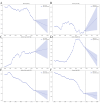Trends and projections of the global burden of thyroid cancer from 1990 to 2030
- PMID: 38751316
- PMCID: PMC11109522
- DOI: 10.7189/jogh.14.04084
Trends and projections of the global burden of thyroid cancer from 1990 to 2030
Abstract
Background: We aimed to explore the burden of thyroid cancer worldwide from 1990 to 2019 and to project its future trends from 2020 to 2030.
Methods: Based on annual data on thyroid cancer cases from 1990 to 2019 available in the Global Burden of Disease (GBD) database, we calculated the age-standardised incidence, death, and disability-adjusted life year (DALY) rates for thyroid cancer. We used the estimated annual percentage change (EPAC) to quantify the temporal trends in these age-standardised rates from 1990 to 2019 and applied generalised additive models to project the disease burden from 2020 to 2030.
Results: The global age-standardised incidence rate (ASIR) of thyroid cancer increased from 1990 to 2019, with a higher overall disease burden in women than in men at both study time points. The male-to-female ratios for the ASIR increased from 0.41 in 1990 to 0.51 in 2019, while the ratio for the age-standardised death rate (ASDR) increased from 0.60 to 0.82. The models predicted the United Arab Emirates would have the fastest rising trend in both the ASIR (estimated annual percentage changes (EAPC) = 4.19) and age-standardised DALY rate (EAPC = 4.36) in 2020-30, while Saint Kitts and Nevis will have the fastest rising trend in the ASDR (EAPC = 2.29). Meanwhile, the growth trends for the ASDR and age-standardised DALY rate are projected to increase across countries in this period. A correlation analysis of the global burden of thyroid cancer between 1990-2019 and 2020-30 showed a significant positive correlation between the increase in the ASIR and socio-demographic index (SDI) in low-SDI and low-middle-SDI countries.
Conclusions: The global burden of thyroid cancer is increasing, especially in the female population and in low-middle-SDI regions, underscoring a need to target them for effective prevention, diagnosis, and treatment.
Copyright © 2024 by the Journal of Global Health. All rights reserved.
Conflict of interest statement
Disclosure of interest: The authors completed the ICMJE Disclosure of Interest Form (available upon request from the corresponding author) and disclose no relevant interests.
Figures







References
-
- Davies L, Morris LG, Haymart M, Chen AY, Goldenberg D, Morris J, et al. American Association of Clinical Endocrinologists and American College of Endocrinology disease state clinical review: the increasing incidence of thyroid cancer. Endocr Pract. 2015;21:686–96. 10.4158/EP14466.DSCR - DOI - PMC - PubMed
MeSH terms
LinkOut - more resources
Full Text Sources
Medical
